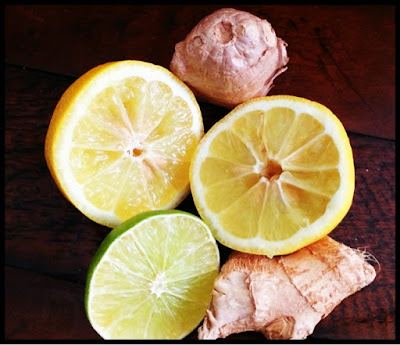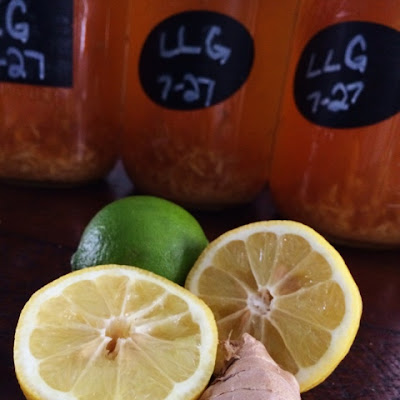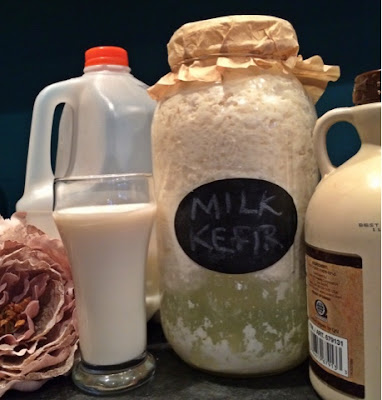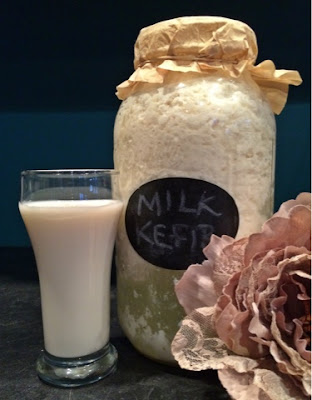Our favorite drink
The recipe for which I always have ingredients on hand.
The flavor that we keep on tap in our fridge.
...Seriously...
I'll post a picture, I just have to clean up the fridge a bit first.
We don't run out of this drink.
The only time that I have drank soda in 9 months is when we have ran out.
Not only do I love this flavor, but my girls love it! It is their favorite as well.
Not only do I love this flavor, but my girls love it! It is their favorite as well.
(Results may vary with children.
My girls love ginger and are little foodies. The first restaurant that my eldest asked to go to by name was a local Cajun place and the first food our youngest loved was Indian. Odd, but in a good way.)
My husband, not so much, but I have yet to convince him of the health benefits.
Another great thing about this flavor combo is that you are not adding more sugar to the ferment. The bacteria and yeast continue to eat the sugar added at the beginning of the first ferment. This results in a low sugar content kombucha that still packs a wallop of flavor.
My husband, not so much, but I have yet to convince him of the health benefits.
Another great thing about this flavor combo is that you are not adding more sugar to the ferment. The bacteria and yeast continue to eat the sugar added at the beginning of the first ferment. This results in a low sugar content kombucha that still packs a wallop of flavor.
But, let me say, as much as we love this drink, this is not the flavor that I start with
for non-kombucha drinkers.
The Blackberry Lavender or Pina Colada (recipe coming soon) are better starting flavors. These are the flavors that my husband prefers. He actually likes both of these quite a bit. He will drink them if I set a glass in front of him, but he still won't seek it out. One of these days...
The Blackberry Lavender or Pina Colada (recipe coming soon) are better starting flavors. These are the flavors that my husband prefers. He actually likes both of these quite a bit. He will drink them if I set a glass in front of him, but he still won't seek it out. One of these days...
But, if you love ginger or ginger ale, and are ready for an addicting tangy, sour, sweet, and slightly spicy with the ginger kick, this one is for you!
The acidity from lemons and limes does a wonderful job of cutting through the sour vinegary-ness that is a natural side effect of the healthy yeast and bacteria munching away during the fermentation process. *I recommend, as you try your own flavor combinations, to include lemon or lime in most flavors, even if it is only 1/2 lime per 1/2 gallon of fermented tea.*
First, complete the first fermentation of the tea. Click here for detailed directions.
When the tea has reached the right color, smell, taste, and effervescence (and pH, if you are testing, which you should be doing every three or four batches, at least). Yes, trust me, you will quickly learn how to read the signs that your tea is done with the first ferment. I realized that as the summer heat started taking affect on my kombucha. My tea went from fermenting in 7 to 9 days to fermenting in 5 days! I want to let the first ferment go as long as possible, without it going too vinegary, because the longer it ferments, the more probiotics, minerals, vitamins, and other nutrients are produced.
But I digress...
But I digress...
Here is the recipe for:
Lemon Lime Ginger Kombucha
- 1 gallon fermented tea
- 3 1/2 gallon mason jars
- 2 wide mouth mason jar lids (the rings and lids for an air tight seal)
- Plastic strainer
- Plastic funnel
- Juicer
- Coffee filter
- Rubber Band
- 2 lemons
- 1 lime
- 6-7" of ginger
- 5 to 7 black tea bags (or equivalent)
- 2 to 3 green tea bags (or equivalent)
- 1 cup of sugar (unprocessed is preferred)
- 1 gallon spring water
I prep for my next batch before I start moving my tea for it's second fermentation.
Here is what to do to prep for your next batch.
This keeps your SCOBY from sitting out too long with only 1 1/2 cup fermented tea.
Here is what to do to prep for your next batch.
This keeps your SCOBY from sitting out too long with only 1 1/2 cup fermented tea.
Start your next batch of tea for it's first
fermentation by brewing 7 - 9 bags of tea
in a 1/2 gallon mason jar. I use a combination of black (5 to 7) and green (2 to 3).
in a 1/2 gallon mason jar. I use a combination of black (5 to 7) and green (2 to 3).
Brew with 10 minutes.
Add 1 cup of sugar. Shake to combine.
Allow to cool.
Now go to your gallon jar that holds your tea that has completed the first fermentation:
After the first fermentation, remove the SCOBY and approximately 1 1/2 cups of the fermented tea. Place in a bowl rinsed with really hot water and then vinager (this is how everything should be sanitized)
Pour the fermented tea into two 1/2 gallon mason jars.
Juice 1 lemon into each of the 1/2 gallon mason jars.
Do the same with 1/2 a lime in each.
Wash the ginger with hot water.
Wash the ginger with hot water.
Grate or finely dice the ginger. Add 3-4 inches worth into each jar. (Depending on your preference.
Close with mason jar lids.
If you have chalkboard labels, write the type and the date the 2nd fermentation will be complete.
Close with mason jar lids.
If you have chalkboard labels, write the type and the date the 2nd fermentation will be complete.
Allow to sit, out of direct sunlight, for two days. Watch for the tops popping up. You may want to burp them (loosen the lid to allow a little air to escape, then re-tighten) if the top is raised or you are seeing a lot of bubblies happening.
Strain the flavored fermented tea into the bottling solution of your choice.
Refrigerate.*
Drink and feel good food knowing that you are enjoying a drink that is helping your whole body.
Drink and feel good food knowing that you are enjoying a drink that is helping your whole body.
Start your next batch:
Add cooled 1/2 gallon of sugared tea to 1 gallon container.
Add another 1/2 gallon spring water.
Add SCOBY and reserved tea from the previous batch that your SCOBY has been swimming in.
Cover with a coffee filter secured with a rubber band.
Cover with a coffee filter secured with a rubber band.
*Refrigeration will greatly slow down the fermentation process. It does not completely stop fermentation
though, so, if you leave a bottle in the fridge for a couple weeks, if
it is happy kombucha, it will start to create a new SCOBY and free
floating yeast. This does not mean it has gone bad, quiet the
opposite. Like I said; this is a sign of happy, healthy kombucha. All
you need to do is strain the drink into a glass before drinking. I am
now really used to the whole SCOBY concept, so I sometimes don't bother
to strain it. That SCOBY is really good for you!
But then I remember that I am eating one of my baby civilizations, and feel a bit guilty... But I get over it.
Let me know what you think. Did you crave this flavor after your first glass or was it too tangy/spicy?
How are your SCOBY's doing?
Let me know what you think. Did you crave this flavor after your first glass or was it too tangy/spicy?
How are your SCOBY's doing?









